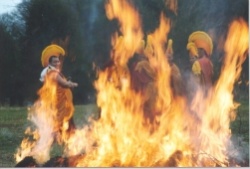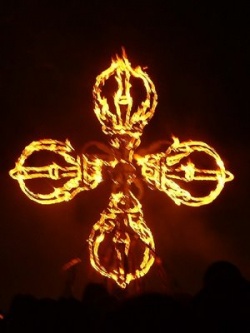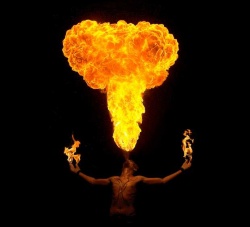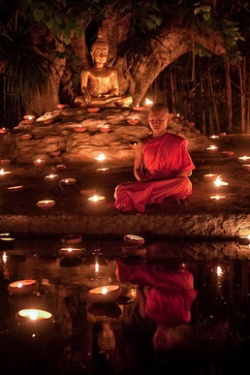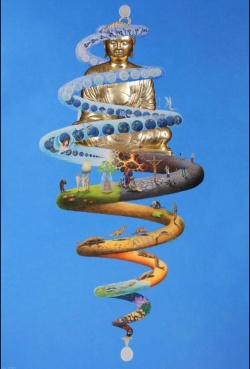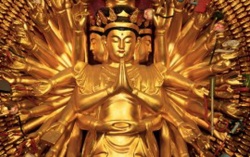The Ritual Fire Offering
(This description is intended for practitioners of tantra who have taken refuge and have received initiations.
Pujas for ordinary persons are shorter (about 45 minutes), less elaborate, and less complicated.
However, the following information will give the general reader some idea what a fire puja is about.)
After receiving an initiation, one practices the tantric path, bound to accomplish the welfare of sentient beings.
To be capable of doing this one must become enlightened, and on the initial stage of the tantric path to this goal, one must closely identify with the deity whose practice one is pursuing by meditation on the deity, reciting his/her mantras and by making a ritual fire offering.
Performing the ritual fire offering pleases the deities who help the disciple gain accomplishments on the path.
It also serves to remove the faults of badly or incompletely recited mantras and removes obstacles to a good meditative stabilization.
There are four types of ritual fire offerings:
- Peaceful,
- Increasing,
- Subduing
- Forceful.
A Peaceful Ritual Fire Offering may be performed to pacify the results of unwholesome action, or to clear away obstacles and defilements.
It may also be done to forestall impending difficulties and illnesses which have manifested themselves through dreams and inauspicious omens.
Peaceful and Increasing Ritual Fire Offerings can be performed for both one’s own and other’s benefit.
Whereas the Subduing and Forceful Rituals can only be performed on behalf of others, for to forcefully subdue others for one’s own benefit would contradict the conduct of a Bodhisattva which is fundamental to Buddhist tantric practice.
A Subduing Ritual Fire Offering may be performed to subdue forces that are harming other sentient beings.
A forceful ritual fire offering is performed against harmful forces or people, if attempts to subdue them have failed and they continue to harm others.
A Forceful Ritual Fire Offering can be banish or instill such fear in the victim that he ceases to be harmful.
When performing such a forceful ritual the master must be motivated purely by great compassion, not only for those being harmed, but also for those who are harming them.
In Tibet these rituals were most often employed to dispel or subdue local disturbances, such as the harmful interference of spirits, possession by spirits, military aggression and so forth.
The Site
Fire offerings are usually performed outside on open ground or on the roof of a house.
In India, there appears to have been a practice of making ritual fire offerings in a building dedicated to that purpose, but this tradition did not spread to Tibet.
Having visualized himself as the deity he is closely identifying with, the practitioner, who is referred to as the master of the ritual, offers ritual cakes to the local gods and seeks their permission to perform the ritual offering.
He imagines that they gave assent. To clear away any faults of the site, he recites mantras and to rid it of obstacles, he meditates on emptiness.
Drawing The Hearth For The Peaceful Ritual Fire Offering
A smooth square raised platform of earth is whitened. In the center is drawn (usually with colored chalk) an eight petal led flower, a cubit (twenty-four-finger widths) in diameter, which is referred to as the hearth.
In the center of this is a vajra eight finger-widths long.
Outside the flower is a ring four finger-widths wide on which the fire-wood is placed. Outside this is a four finger-width ring of vajras.
A square is drawn whose sides are two finger widths from the ring and whose corners are marked with a half varja and a half moon. The space outside this is scattered with flowers.
Drawing The Hearth For The Fire Offering For Increase
The basis for the hearth is same as before, but here the central design is an eight spoke wheel with a jewel at the center.
Around the wheel is a square, the sides of which are eight finger-widths from the wheel’s rim, on which the fire-wood is placed.
Outside this is a jewel fence of the same width surrounded by a square at the four corners of which are the half vajra and half moon.
The remaining area outside this, half a cubit wide, is scattered with flowers.
The Implements
A throne is built with a low wall to protest against the fire in front of it.
For both peaceful and increasing offering this wall is painted white and the syllable BAM, representing the water element, is drawn on it.
To the right of the throne is a table spread with a white cloth for a Peaceful ritual or yellow for Increase, on which are set out the five kinds of offerings of which there are two sets.
These are
- Four cloths, white for peace, yellow for Increase.
- Three different kinds of substances in butter, representing paan; (an astringent mixture wrapped in betel leaf and chewed in India)
- Ritual cakes to offer the gods, which are white or yellow respectively.
- Sticks of fresh wood, which should be twelve finger-widths long.
They should be cut from the tips of the branches, and should be fresh, green, not rotten and have their bark intact.
They should be straight, free of holes, of equal size and cut straight.
Honey and butter is applied to the tips.
All these ingredients are rubbed with butter and honey.
Boiled rice mixed with molasses, curd, honey and sugar.
This are special substances for the Peaceful fire offering, also curd, milk, sesame seeds, boiled rice, puffed rice, kusha grass, couch grass, sandal wood and fragrant white flowers.
These are rubbed with vegetable oil and honey.
For an Increase Ritual Fire Offering the ingredients are the same, but as many as possible should be colored yellow.
All the ingredients are arranged in heaps, in a row.
There is also a white or yellow vase (depending which ritual is being performed) containing the four waters: to wash the hands, feet and mouths of the deities and to sprinkle on them.
The Fire
For a Peaceful Ritual Offering, the fire should be taken from one of the following:
- a fire lit from rubbing two pieces of wood together
- a household fire
- a fire in a very isolated place, or
- fire from a previous ritual offering
For an Increasing Ritual Fire Offering the fire should be taken from a king’s fire, a fire lit from a jewel, or the fire in a monk’s kitchen.
The Practitioner’s Attire
The practitioner and his ritual assistants should be very clean.
A layman should wear white clothes for peace and yellow for increase. Monks may wear the costume of the deity over their robes to help them visualize themselves as the deity
Further Requirements
The quantities of ingredients offered during ritual fire offerings can vary.
In order to perform this ritual, the practitioner must have received an initiation into the practice of the deity for whom he is performing the ritual fire offering and must have recited the required mantra at least one thousand times.
He must also hold the Bodhisattva and Tantric vows. A more lengthy retreat may comprise the recitation of as many as one or two million mantras.
If elaborately performed, the fire ritual which follows can involve, depending on the practice, offerings which number one tenth of the total mantras recited.
One tenth of these offerings are made to the Fire God and the ritual fire offering is made with three handfuls of each ingredient being offered to the Fire God and a large quantity offered to the main deity.
If the practitioner directly perceives the deity during his retreat, the recitation of many mantras and the ritual fire offering aimed at strengthening their relationship are no longer necessary, since the ultimate aim has already been achieved.
On the morning of the Ritual Fire Offering, before sitting on the throne, the master and the monks visualize the deity, make offerings to him of water, flowers, ritual cakes, and so forth, and recite his mantras.
The Actual Ritual Preliminaries
The practitioner sits on the throne, with his ankles crossed if he is performing a Peaceful Ritual Fire Offering or with his feet down-like Maitreya-if the ritual is for Increase.
The assistants sit beside him or in a row facing him.
On a small table next to the practitioner are a vajra and bell, a vase, a skull cup containing the inner offering and a damaru (ritual drum)
The practitioner and his assistants meditate on love and compassion, and visualize a complete mandala (celestial mansion), in which dwells the deity.
This mandala varies according to the deity one is making the offering to.
If it is a meditation deity, as is most common nowadays, the visualized mandala is that deity’s mandala.
But if the offering is to a protector, since one cannot meditate on a protector’s mandala, the one visualize here is different.
Of the two vases next to the practitioner, one is for sprinkling water, the other is for making the four water offerings.
The water from this latter vase is poured into three conch shells.
When the times comes for each of the four water offerings, it is poured into the offerings vessels.
In both cases, the water is prepared in advance and blessed by the recitation of mantras.
The practitioner and his assistants again meditate on love, compassion and the empty nature of all phenomena, then they offer a ritual cake to the local spirits and other non-human beings dwelling at the site, requesting them not to obstruct the ritual and to take whatever benefit they can from it.
The words of this request should not deviate from those in the texts.
Mindful of their symbolism, the practitioner and his assistants must hold the vajra and bell in their hands throughout the ritual.
Next, water from the vase is sprinkled over the hearth, the ritual implements and the offerings to clear away any obstacles and impurities affecting them.
The offerings are blessed by meditating that they dissolve into emptiness and arise again as the essence of emptiness, free of all defilements.
Mantras are recited to eliminate impurities from the fuel, the butter and so forth.
A torch, which is a long stick the end of which is wrapped with dry clean grass tied with white scarf, is then lit and water is sprinkled to clear away obstacles before lighting the fire.
The burning torch is placed through a gap in the stacked wood.
A square blue cloth stretched between two sticks serves as a fan which is waved seven times over the fire as melted butter is poured onto it.
Kusha grass, acclaimed in ancient India for its purifying qualities, is also meant to dispel obstacles.
The practitioner throws two pieces of grass over the fire representing a protective covering.
In India the quantity would have been much greater, but was reduced to a symbolic amount in Tibet due to its relative unavailability.
The Fire Offering
Water is sprinkled over the hearth to remove obstacles once more.
The practitioner visualizes that the hearth dissolves into emptiness, from which arises Vairochana, who transforms into a hearth, which is of the essence of wisdom.
It is pure and has all the qualities of a hearth for a peaceful ritual fire offering.
Within the hearth is a triangular fire in the midst of which stands the Fire God (Agnidevatta).
He has a white body, three faces, the front white, the right red and the left black and six arms.
His right leg is bent and his left is out stretched.
From a triangular fire at his heart radiates a beam of light which draws forth an emanation, who comes to stand on the kusha grass before dissolving into that fire.
The Fire God is always invoked so that the offerings are not consumed by ordinary fire.
In order to attract him initially, someone making a ritual fire offering for the first time can make him a special gift of one tenth of the total offerings.
After this, it is said that he will come whenever summoned. Of the two sets of offerings on the table, one is for the Fire God and the other is for the meditational deity or protector to whom the ritual fire offering is being made.
Water from the vase is sprinkled, flowers are scattered, and the melted butter is poured onto the fire. The latter is poured from a long-handled ladle through a square funnel also on a long handle.
The practitioner imagines pouring the butter seven times into the Fire God’s mouth.
The butter should be imagined as the essence of nectar.
The general purpose of the offering is to remove obstacles to enlightenment by removing stains left by ordinary unwholesome actions, especially broken pledges, and to prevent all inauspicious circumstances.
However, each offering also has a specific purpose.
They are described in the order in which they are made.
Offering melted butter is to increase life span, merit and prosperity.
The practitioner imagines that the Fire God has pledged to help achieve all these.
The sticks, the kusha and couch grass are offered to increase the brightness of the deity.
The sticks are offered in pairs, care being taken not to reverse the tops and bottoms.
These remove obstacles to one’s well being and high status.
Sesame seeds are offered to remove non-virtues, couch grass to increase the life span, rice to increase merit, rice with curd to increase happiness, kusha grass for protecting from impurities, mustard seeds to clear obstacles, coarse unhusked barley to increase wealth, barley to gain rapid accomplishments, lentils to increase strength, and wheat to overcome illness.
The many mixed or ‘special’ substances increase wisdom.
The highest accomplishment which is common to the aims of all these offerings is enlightenment.
A Peaceful Ritual Fire Offering performed after a retreat compensates for faults of unclear meditative stabilization poorly recited and badly or incompletely said mantras.
In the case of an increasing ritual fire offering, the offerings to the Fire God are made to increase lifespan, merit, wealth and the wisdom of hearing, thinking and meditating.
The second set of offerings is made to the meditational deity or protector.
The practitioner blesses the offerings, visualizing them dissolving into emptiness then reappearing possessing the nature of emptiness.
Next, he visualizes the complete celestial mansion of the meditational deity, with each deity in his allotted place, emerging from the heart of the Fire God.
If the deity has no mandala, the practitioner visualizes him on his seat or vehicle.
When a mandala is involved, one of the assistants prostrates before a representation of it, such as a painting on cloth, and prays to the principal deity, stating that the ritual is being performed in order to attain the desire accomplishment, and requesting the deity to enter the mansion visualized in the fire.
The assistant then takes a handful of grain in a bowl and circles the mandala reciting the mantras invites each deity from the mandala into the bowl, which also contains some small pieces of cymbals and trumpets he circles the hearth three times and offers the bowl to the ritual master.
The master throws the grains into the fire while reciting the deity’s mantras and visualizing that they have left the bowl and entered the celestial mansion he has visualized in the fire.
At this point the second set of offerings is made.
These are more numerous than those made to the Fire God, but the procedure, order and the benefits are the same.
After each offering to the principal deity, a small amount is offered to his entourage.
When the offerings are complete, the practitioner sprinkles water from the vase over the fire, thinking that impurities are thus removed.
Melted butter and flowers are offered to the deities, then a ritual cake, which is thought of as being essentially nectar.
Next, two clean pieces of cloth representing an upper and lower robe are put into the fire, followed by butter and honey (paan) and again, flowers. Praises are recited to the deities, who are asked to be patient with any mistakes that may have been made.
Requests are made that the desired accomplishments may be attained.
When there is no physical representation of the mandala, merely a visualized one, the wisdom being is asked to return to it, while the pledge being dissolves into the master.
However, when there is separate representation of the mandala, such as a painting, the deities are visualized returning to it from the mansion in the fire via the bowl of grains, which again is carried by an assistant accompanied by the sound of cymbals and trumpets.
The seven offerings are made to the Fire God who remains, and in the same order as before, a small amount of all the substances, the wood, grass and so forth.
The seven offerings are made again, followed by the offering of a ritual cake and praise.
The master requests the Fire God’s help and support to protect him from disease and that he may gain long life and wealth.
He is asked to bear with any mistakes which may have been made during the ritual.
Having initially invited him for the purpose of self and others, the master bids him to leave, requesting him to return when his presence is required again.
The wisdom being returns to its natural abode, while the pledge being reverts once more to the essence of fire.
If there is time, the fire should be left to burn out on its own.
Otherwise, in the case of a Peaceful Offering the fire should be put out with a mixture of water and milk.
While for an Increasing Offering, fragrant water should be used.
Finally, the ashes which remains should be put into urns to be taken to running water into which they are thrown.
(extracted from Choyang vol. 1-No.2 1987)
